The Independent's journalism is supported by our readers. When you purchase through links on our site, we may earn commission. Why trust us?
Nintendo Switch OLED review: The best version of the console yet
Its ultra vivid display and premium good looks are here to dazzle – but is it worth the upgrade?
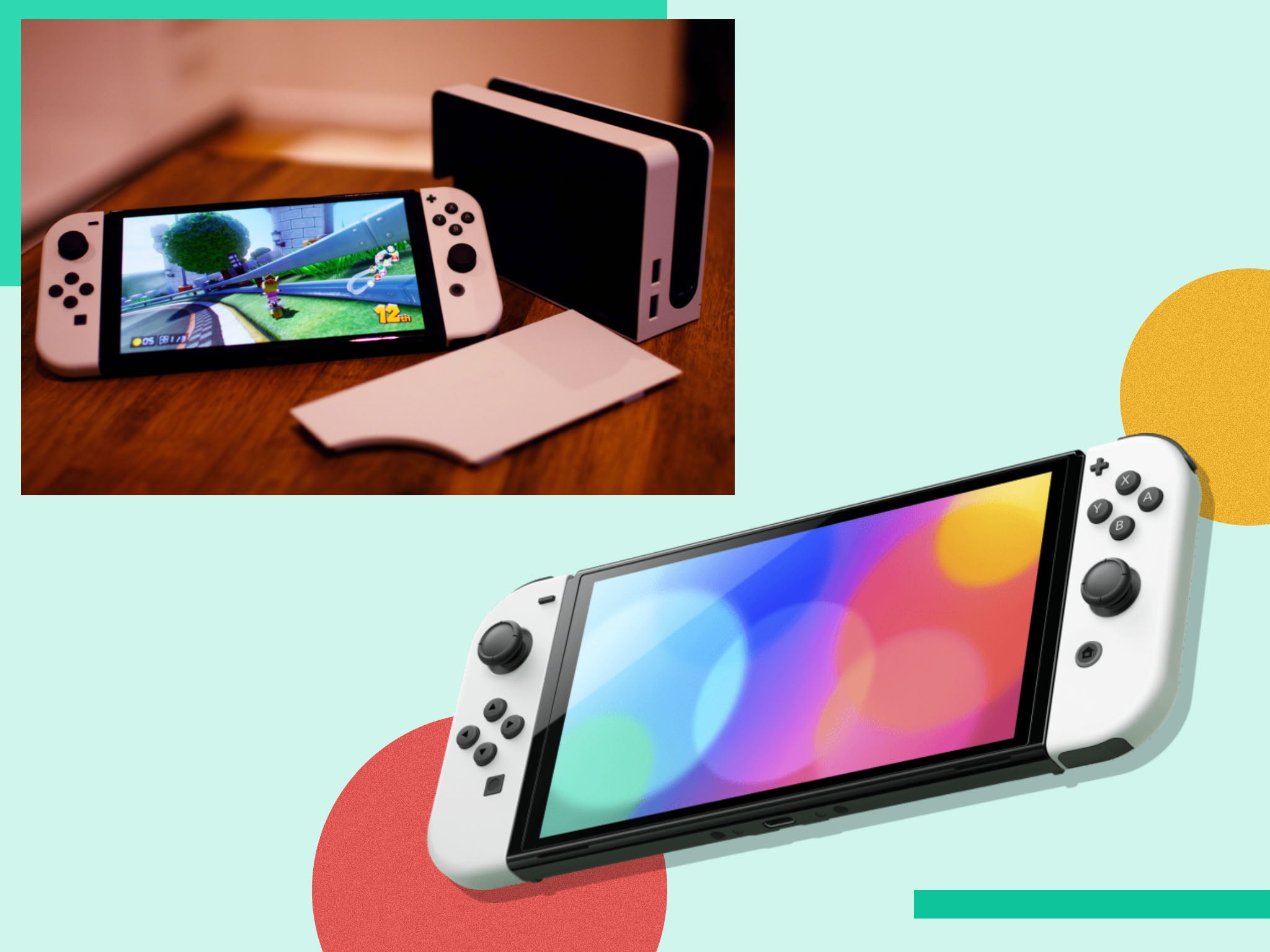
In the lead-up to Nintendo’s announcement of the Switch OLED, the hype was, as they say, very real. A 4K capable system in docked mode, a potential 1080p display, maybe even a more powerful processor. The rumour machine was at full churn.
Of course, in true leak fashion, none of that came to pass. Instead, what we have in our hands is a more modest upgrade, but one that fixes almost every minor quibble we have with Nintendo’s wildly popular original Switch console (£259, Amazon.co.uk), now available with some serious reductions.
It’s an upgrade that will primarily please handheld and tabletop Switch gamers, with its larger, more handsome OLED panel and the refined kickstand, but less so those who prefer to throw their bananas and blue shells while racing around tracks on a 65in TV.
For those new to the Nintendo Switch ecosystem, buying the OLED model is an absolute no-brainer, but it may be more of a quandary for those still rocking the company’s first hybrid device. We’ve had the Switch OLED in our hands for a week now, and we’ll hopefully help answer that very question.
Read more:
How we tested
We pitted the new OLED model against the original Nintendo Switch, playing two bright, bold games – Mario Kart 8 and The Legend of Zelda: Breath of the Wild. Of course, we notched both consoles up to full brightness, placing both side by side to compare the display of both models, noting any improvements to the original. We also played with the Switch OLED outdoors in the sun to test whether we still get that wretched screen glare.
On top of that, we looked at how the console’s overall design has evolved, eyeing up the new base with the added ethernet port, as well as looking at whether the console’s new kickstand is up to snuff. We also set those new stereo speakers on full blast and went over the console’s specs, looking at what’s different in the new model.
Nintendo Switch OLED: £309.99, Argos.co.uk
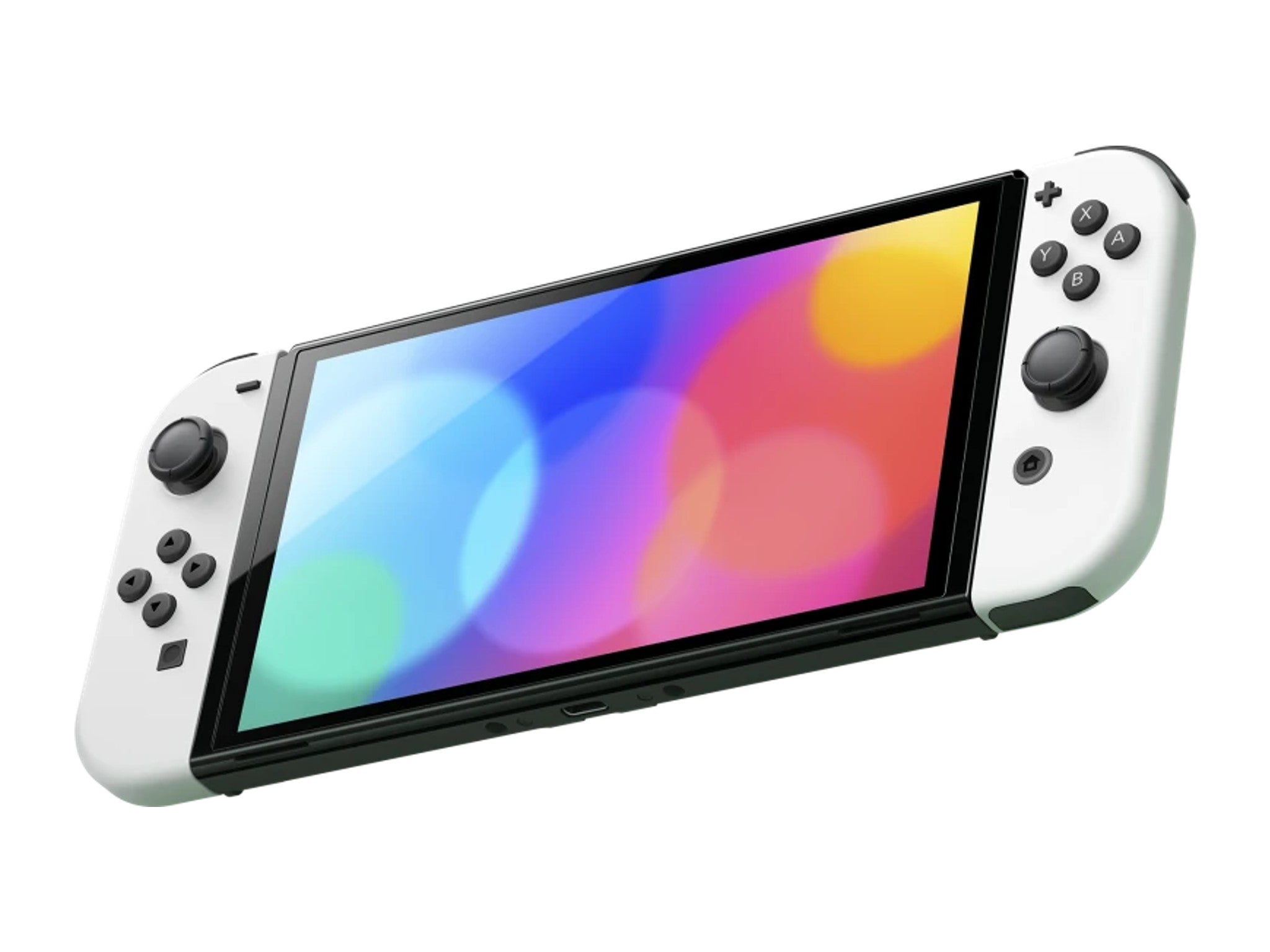
- Dimensions: 4in x 9.5in x 0.55in
- Weight: 0.32kg without joy-cons, 0.42kg with joy-cons attached
- Display: 7in multi-touch capacitive OLED touch screen (1280x720)
- CPU/GPU: NVIDIA custom tegra processor
- Storage: 64GB, micro SD
- Video output: Up to 1080p in TV mode; up to 720p in handheld and tabletop mode
- Battery life: 4.5 to 9 hours
- Charging time: 3 hours
- Rating: 9/10
The new and improved display
Let’s start with the Nintendo Switch OLED’s biggest upgrade over the original – that gorgeous new glass display. When we placed the two consoles side-by-side and ignored that one had a fresh new lick of paint, the two devices don’t actually look all that different. Despite one having a larger 7in display, their bodies are fairly similarly proportioned to each other. And that’s a good thing. You get a bigger, more vibrant screen without increasing the overall real estate of the Switch.
We did notice one pretty significant difference straight away: those big black chunky bezels on the OG Switch had been pretty much halved on the new model. The borders are significantly slimmer on the OLED version. It’s not an edge-to-edge display, but it stretches pretty close to the bottom and top of the system, just making it feel like a sleeker, more modern console, even when turned off. Plus, the fact that the display is all glass adds to the premium feel.
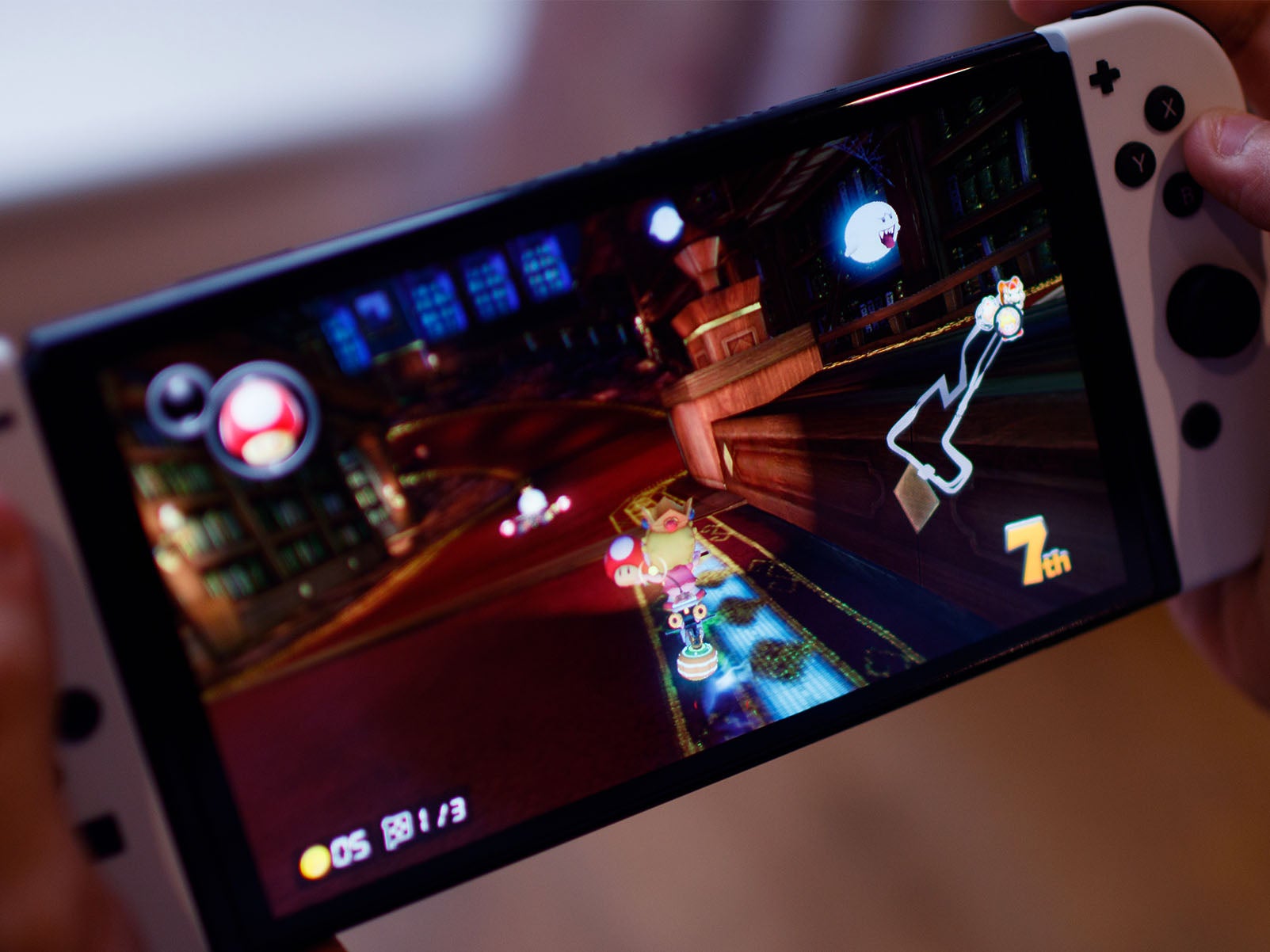
Turn them both on, and the differences become instantly apparent. When the system boots up and you get that rich red splash screen instead of a slightly washed out alternative, you already know that this is going to be a better handheld console than the current Nintendo Switch. It just becomes even more pronounced when you start playing some actual games in handheld mode. And fans of the brand will know, Nintendo games are basically explosions of sugar-sweet vibrant colour.
We did the majority of our testing on Mario Kart 8 Deluxe, racing around tracks like rainbow road, cloudtop cruise, ribbon road and twisted mansion, as well as The Legend of Zelda: Breath of the Wild.
The blacks in twisted mansion and dark skies of rainbow road are noticeably pronounced, and they actually look truly black and dark, rather than the dark grey we get when playing the same tracks on the original Nintendo Switch. When racing on cloudtop cruise and ribbon road, colours simply came to life, popping out of the screen, when the same tracks looked a little flat on the base model.
Read more: 10 best Xbox One games for every kind of player
The flush meadows and alpine mountains looked even more beautiful in Breath of the Wild, and the game is a real showcase of how much more enticing everything looks when playing it on an OLED screen.
You’ll really notice the deep blacks on a game like Metroid Dread, which is out on 8 October. From the trailers, it looks like the colour palette is made up of darker shades, but we didn’t get a preview ahead of this review.
There’s also a new setting in the system menu called “console screen vividness”, with two options to choose from – vivid or subdued. Vivid is turned on by default, and switching over to subdued does, well, what it says on the tin – washes out the colours a little bit. Once you turn the subdued mode on, you’ll see exactly why vivid mode is turned on by default – it just makes everything bolder and brighter.
The disappointing thing, though, is that because it’s still a 720p resolution screen, it still doesn’t feel like the sharpest display around. While the colours pop, we’re still left craving a little more clarity to the picture.
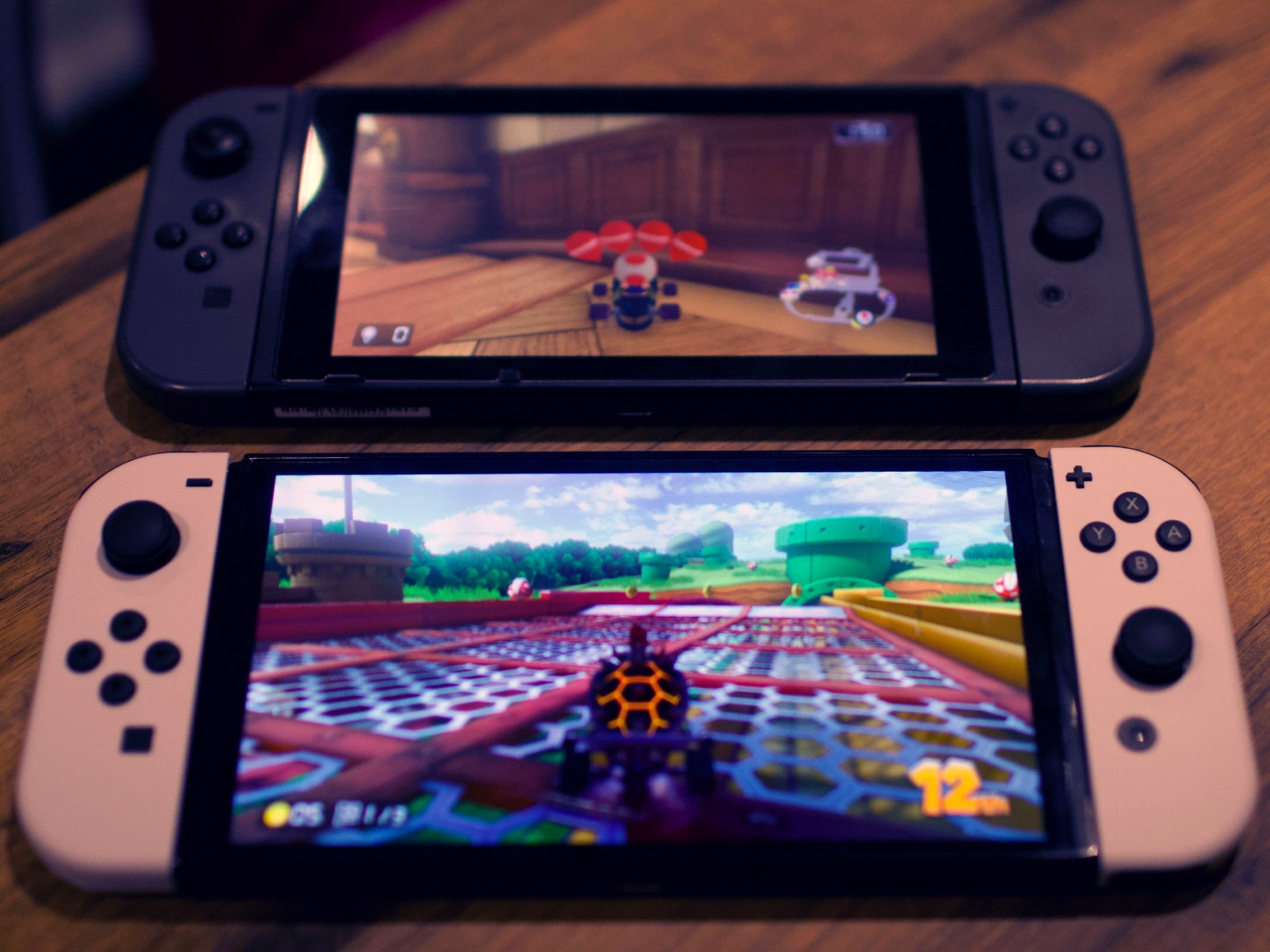
The display is also a touch brighter than its older sibling, although we still did have a few issues playing on it in the sun – the problems with glare are still there. It’s sometimes tricky to make out what’s happening on-screen while playing outdoors, but notching it up to full brightness does help slightly.
And what about the dreaded screen burn-in which can happen on OLED panels? Should we worry? We spoke to Jessica Wade, an engineering research fellow at Imperial College London, who specialises in OLED technology to find out how concerned people should be when playing games on the new console, now that the Switch is full OLED. And the answer is – not very.
Read more: 12 best PC games to play right now
If you don’t know how OLED works, essentially each pixel in a display generates its own light. It’s different to an LCD display on the original Switch, which is backlit by one light. Burn-in typically happens when one static picture is left on for a significantly long period of time. “I don’t think people need to be worried (unless they’re playing one game on super high brightness without switching off the screen for months or years,” she says. “If people are at all concerned about image retention, they can turn down the brightness when they’re at a particularly stationary part of the game.”
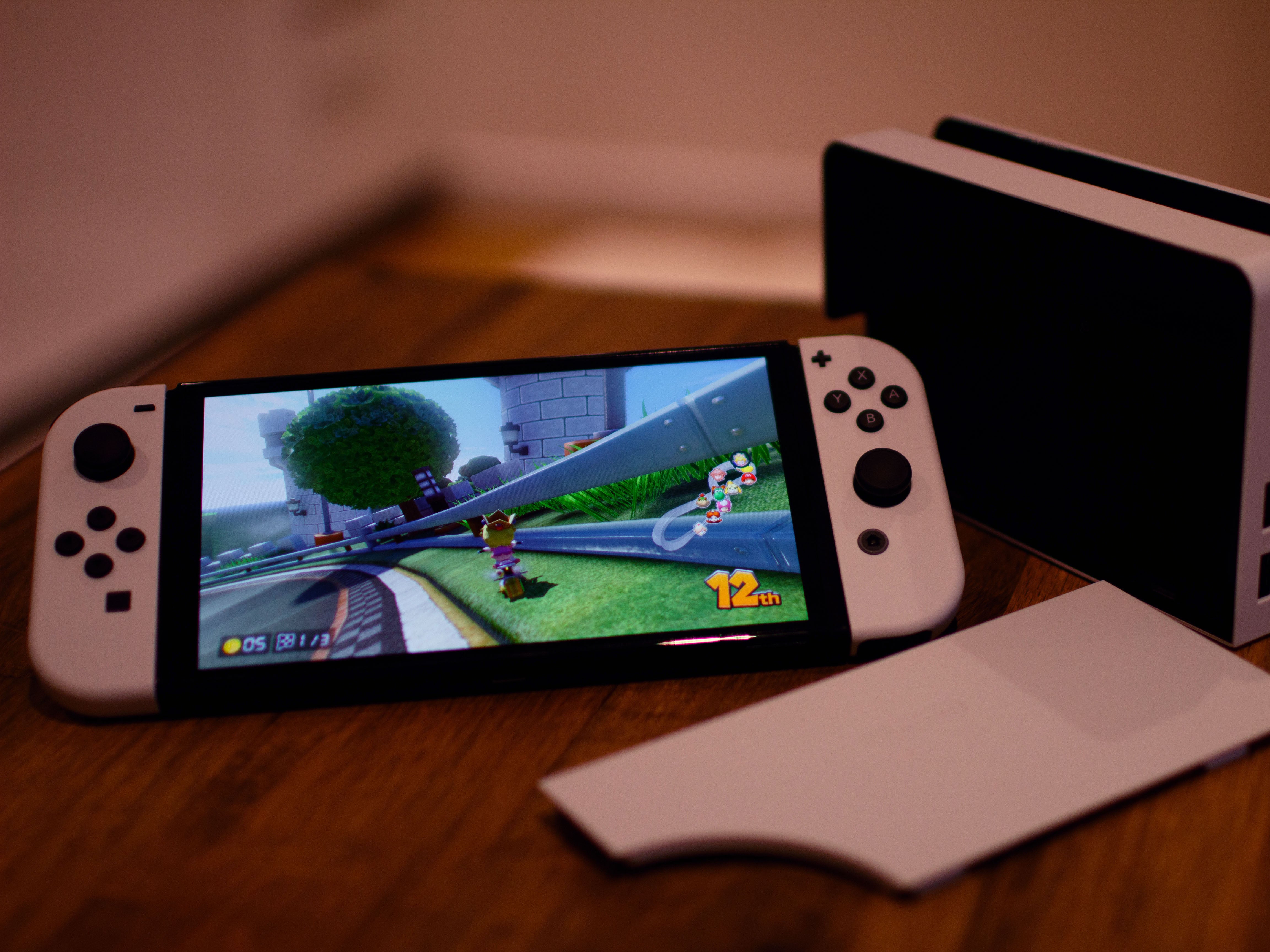
There’s a screen burn-in reduction feature on the TV output settings, which was already toggled on for us, as was the auto-brightness feature, so we wouldn’t be too worried if we were you. “It’s easy to avoid by having a moving screensaver, not leaving your Switch on pause or enabling settings that shift the image around slightly to activate different parts of the screen,” Wade adds.
The kickstand
The build quality of the Switch OLED just feels a whole lot more premium when compared to the Nintendo Switch or the Switch lite. While there’s slightly more heft, it’s not heavy, and the joy-cons don’t jiggle about as much when attached to the rails. As mentioned earlier, the glass screen gives it a more premium feel. The older Switch has a more plastic-like shell, which feels a bit more like a toy and less like a premium games console.
We also can’t forget to mention the new off-white colourway, which just gives the new console some added style. It looks pretty much the same on the top of the device, except you’ve now got a new oval-shaped power button instead of the circular one, but flick the console round, and prepare to fall in love.

The kickstand is absolutely glorious, stretching across the entire expanse of the bottom of the console. It has some nice solid resistance to it, which allowed us to adjust it to pretty much any angle for multiplayer tabletop play, and even magnetically clicks back into place when you push it down. Compare that to the flimsy little lever found on the original Nintendo Switch, which does a frankly terrible job at propping the console up, and you’ll know exactly why we’re so excited about the kickstand.
Read more: 10 best wireless gaming headsets
The charging port is still located on the bottom of the console, but it’s actually easier to charge the device while playing in tabletop mode than it was on the OG model – which was frankly impossible to do. And that’s really down to the fact that you can set it on a table at so many different angles. If you angle the kickstand just a few degrees off the table so that it faces outwards instead of downwards, the charging cable won’t make contact with the table and knock the Switch off balance, fixing a very minor annoyance we had with the base model. You just can’t get that same precision with the previous Switch, with its dinky little toggle.
The Switch OLED dock is largely the same as the current dock, but with a few noticeable differences. First, there’s that new ethernet port on the inside, which replaces the USB-A port, so you don’t have to buy an adapter if you’re going hard on Super Smash Bros. If you like the fact that it’s got an ethernet port but don’t want to upgrade, Nintendo is reportedly going to start selling the dock separately.
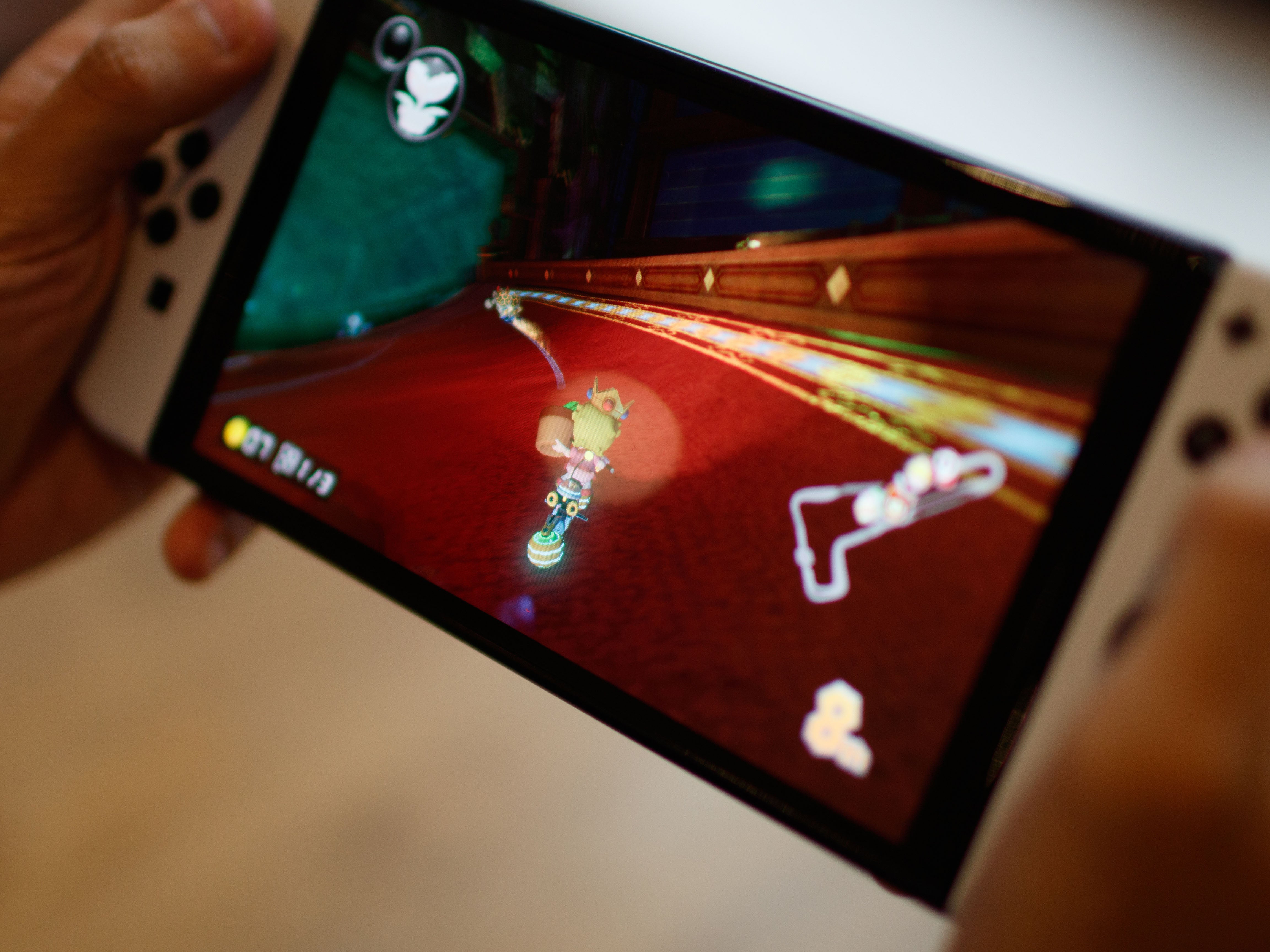
The interior of the dock now has a nice gloss finish, and instead of a hinge that pulls down to give you access to the port, the entire back comes off. We’re a little iffy on this change – we just know we’re going to misplace the back cover at some point, because it doesn’t stay attached like it does with the original dock. While the dock opening is also a little wider, we’d still recommend getting yourself a screen protector if you’re concerned about the sides scratching the screen as you slot it in. It’s still not wide enough for you to not be concerned about that happening.
Battery life and audio
In our testing, we didn’t really see much improvement in terms of battery life, but that was to be expected, with Nintendo still suggesting that you can get 4-9 hours of gameplay on a single charge. Nintendo also says that the Switch has enhanced audio, and honestly, if we didn’t know this detail, we really wouldn’t have noticed that a change had taken place at all.
You have to listen extremely closely to hear any kind of difference, and we think that the OLED model is maybe very slightly clearer than the base model, with fewer grating noises when kicked up to maximum, but not by much. Prick your ears and you can certainly tell that something’s changed for the better here, but don’t upgrade expecting some powerful ear-piercing Atmos-level speakers.
Read more: 9 best 4K TVs for a needle-sharp viewing experience
There isn’t really anything to get excited about if you’re a gamer who primarily plays with the console docked, because it still runs on that same NVIDIA chip, meaning no 4K output on the TV. You do get 64GB of onboard storage instead of 32GB, but you’d still want to slot in a micro SD if you have a cart-load of games. Those DLCs do start to add up after a while. And there isn’t any change when it comes to RAM or CPU.
The verdict: Nintendo Switch OLED
Handheld and tabletop gamers, this new model is really designed for you, but does that mean you should upgrade for the latest and greatest? Here’s the situation – the larger display is fantastic and playing games in handheld mode is an absolute joy. The kickstand feels so solid and makes us never want to look at that little toggle on the back of the original Switch ever again.
But those are the two main things that you’ll be paying an extra £50 for, so that’s something you need to weigh up when making your decision. Are those features attractive enough for you to take the plunge?
On the other hand, if you’re new to Nintendo Switch and have never bought one before, this is absolutely the best version of the console yet. Sure, it might not be the pro model we were all hoping to see, but its colourful display, better build quality and bigger storage makes it a no-brainer. New to Nintendo? Buy the Switch OLED console and never look back.
Voucher codes
For discounts on games and offers on consoles, try the links below:
Looking to save on Nintendo Switch consoles? Here’s everything you need to know about the best deals
